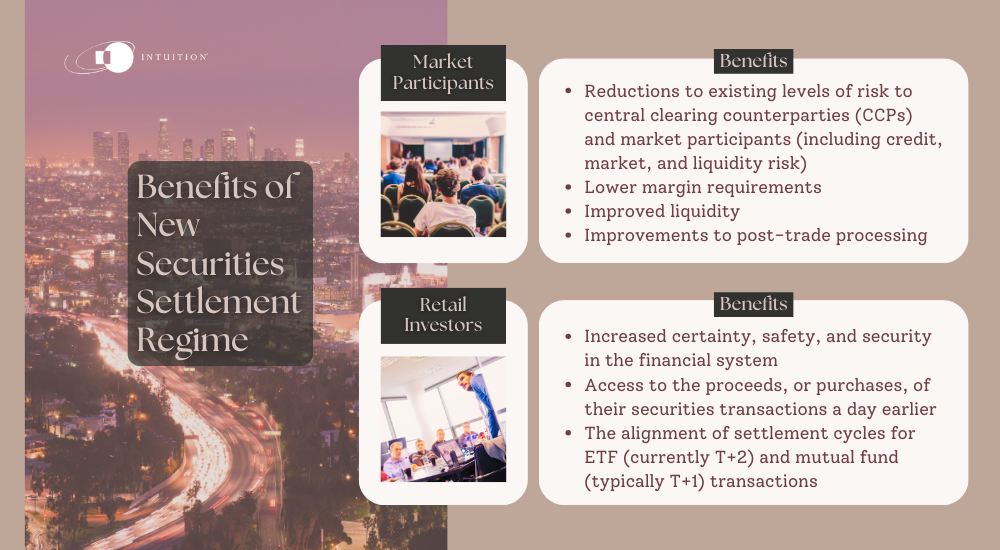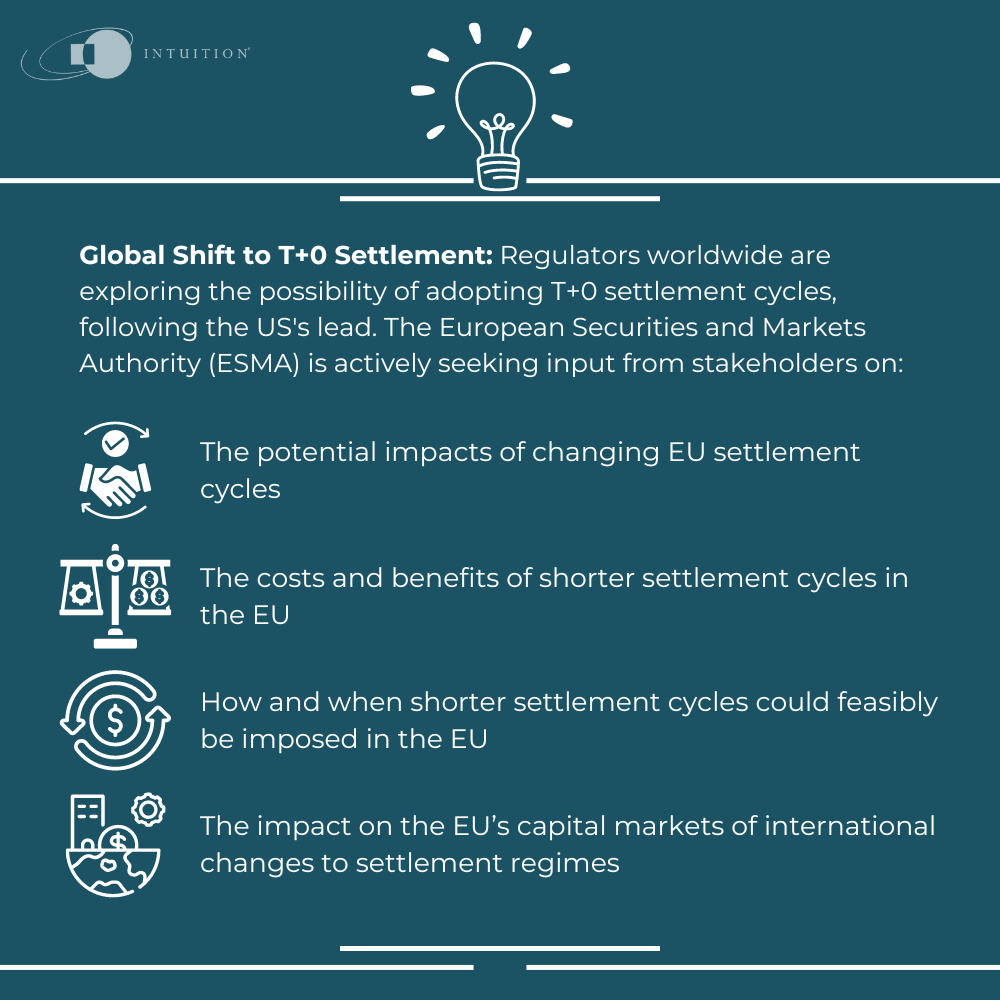Securities settlement – T+1 comes into focus
The imminent launch by the Securities and Exchange Commission (SEC) of a T+1 settlement regime for US securities is set to reduce risk but also pose challenges – especially for market participants and regulators in other jurisdictions that, for the time being, retain a longer settlement cycle and may be forced to follow the US lead in due course.
Prompt settlement of securities transactions has always been an objective of market regulators, as well as being in the interests of market participants more broadly. The shorter the time between settlement and trade date, the less potential for things to go wrong.
Reflecting these desires for faster settlement, the settlement cycle – an involved, multi-stage process, requiring several intermediaries – has been on a path lower over time, enabled by technology. Major milestones to date in the US were the reduction from T+5 to T+3 under the Securities Exchange Act of 1934 and the further reduction from T+3 to T+2 in 2017. The launch of T+1 – the next major milestone to be implemented by the SEC – is scheduled for May 2024.

COVID-era settlement issues a key driver of T+1 initiative
The SEC’s initiative was prompted in part by settlement issues that arose during the COVID-19 pandemic. The settlement process was frequently getting disrupted by, for example, chronic staff shortages at some of the intermediaries involved. As many of these are in far-flung parts of the world, keeping track of staff availability was a related challenge for financial institutions that needed trades settled over this period. These disruptions caused significant delays to the settlement process.
Importantly, these logjams exposed the extent to which the settlement process had lagged other areas of financial services in the push toward greater automation. They revealed that too much of the process was still being done manually given the availability of technology to automate it. This realization, along with the requisite additional technological and operational improvements, have helped to establish the necessary conditions for a T+1 cycle.
The SEC believes the new measure will “promote investor protection, reduce risk, and increase operational and capital efficiency.” The regulator is also using the opportunity of the T+1 launch to advance two other longstanding objectives:
- New requirements for broker-dealers and investment advisors for the completion of trade allocations, confirmations, and affirmations on trade date (often referred to as “same-day affirmation”)
- New requirements for central matching service providers (CMSPs) to promote straight-through processing (STP) of securities transactions
Benefits of new securities settlement regime
Market participants have for the most part reacted positively to the move, citing a range of benefits that include:
- Reductions to existing levels of risk to central clearing counterparties (CCPs) and market participants (including credit, market, and liquidity risk)
- Lower margin requirements
- Improved liquidity
- Improvements to post-trade processing
Retail investors, meanwhile, should benefit from:
- Increased certainty, safety, and security in the financial system
- Access to the proceeds, or purchases, of their securities transactions a day earlier
- The alignment of settlement cycles for ETF (currently T+2) and mutual fund (typically T+1) transactions
There is not too much to dispute regarding the proposed benefits of T+1 itself. In fact, according to the SEC, a large part of any pushback it received in response to its initial ruling was along the lines that T+1 doesn’t go far enough, and that the target should be T+0.

Concerns around mismatched settlement cycles
While the overwhelming consensus of market participants is that T+1 is a “good” thing, some have nonetheless raised concerns, both with the SEC and regulators elsewhere. These concerns relate predominantly to potential settlement mismatches with other jurisdictions that, for the time being at least, will retain T+2 or longer cycles.
These potential settlement mismatches are most likely to affect investment managers with holdings and service providers across multiple jurisdictions, including the US. These jurisdictions may be located in different time zones, with different market holidays and variations in cross-border settlement practices.
Time zone mismatches are likely to be a particular concern for investors in the Asia-Pacific region, for whom the significant time difference versus the US could mean they are effectively trading on a T+0 basis. While this will be less of a concern for Europe-based investors (as the overnight settlement process would at least still begin during the US working day), settlement will still need to be completed in a significantly shorter timeframe.
Meeting T+1 deadlines for US security purchases will also place additional strain on funds’ cash management processes. Overnight (T+1) settlement means that funds purchasing securities will also need to have the cash in place to pay for the securities at shorter notice. This could be particularly difficult for large funds, which might require short-term borrowing. The trouble is there are typically restrictions on how much funds can borrow. European UCITS funds, for example, are prohibited from borrowing more than 10 percent of their net asset value. Any additional foreign exchange transactions that might be required to pay for securities will place further pressure on liquidity and cash management.
Global coordination

These factors increase the risk of not meeting the imminent T+1 requirement, potentially resulting in failed trades. To avert this outcome, a higher level of global coordination and harmonization of settlement cycles is required, according to those who voiced concerns.
Regulators and supervisory bodies outside the US have been sounding out market participants on the prospects of following the US lead, and indeed moving to T+0. For example, the European Securities and Markets Authority (ESMA) has issued a call for evidence to gather stakeholders’ views on:
- The potential impacts of changing EU settlement cycles
- The costs and benefits of shorter settlement cycles in the EU
- How and when shorter settlement cycles could feasibly be imposed in the EU
- The impact on the EU’s capital markets of international changes to settlement regimes
In the meantime – and in advance of the May deadline – those administering funds with exposure to US securities are submitting their plans for approval to various central banks, and other relevant bodies, around the world.
Intuition Know-How has a number of tutorials relevant to the content of this article:
- Life of a Trade – An Introduction
- Life of a Trade – Clearing & Settlement
- Life of a Trade – Scenario
- US Equity Market
- US Bond Market
- Financial Authorities (US) – SEC
- Credit Risk – An Introduction
- Credit Risk – Types
- Liquidity Risk – An Introduction
- ETFs – An Introduction
- Mutual Funds (US) – An Introduction
- Mutual Funds (US) – Investing
- UCITS


